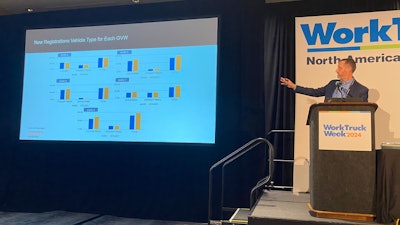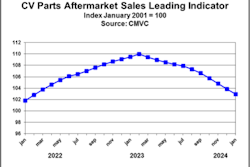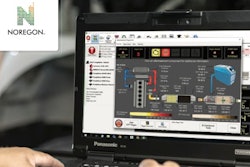
With many segments of the U.S. economy approaching or within a trough in their business cycle, the immediate forecast for truck sales the months ahead isn’t a great one.
But with an inevitable pre-buy looming and indicators that an economic rebound could begin as early as the third quarter this year, Andrej Divis and Steve Latin-Kasper believe any market softening that occurs in 2024 will be shallow and short-lived.
Presenting at Work Truck Week in Indianapolis on Tuesday, Divis from S&P Global Mobility and Latin-Kasper from NTEA stated their guarded optimism that the commercial truck business is in the final stages of a historical reset. Supply and demand are returning to equilibrium after a funky post-pandemic period. The economy is about to pick up, and when it does, Tuesday’s speakers said there is reason to believe truck sales will do the same.
“I think we could look back at [2022-2026] as a remarkable sequence of years,” said Divis, noting if the market even approaches the heights S&P is forecasting for in the years ahead, truck sales will approach levels never before seen in history.
[RELATED: TMC study group working on a used truck trade calculator]
Divis said S&P’s long-term positivity for the Class 4-8 market is mostly rooted in the aforementioned economic rebalancing. While Class 8 truck demand rebounded quickly from the sudden 2020 recession, other vehicle classes were more delayed. He referenced the Class 6 market specifically as a sector that is just now returning to the market share positions it held regularly through 2019.
 NTEA's Steve Latin-Kasper presents at the 2024 Work Truck Show Tuesday in Indianapolis while Andrej Divis with S&P Global Mobility looks on.
NTEA's Steve Latin-Kasper presents at the 2024 Work Truck Show Tuesday in Indianapolis while Andrej Divis with S&P Global Mobility looks on.
“The big lease and rental fleets have come back to the market to replenish their fleets after pausing their buying for a few years,” Divis said.
School buses are another segment on the rise. Latin-Kasper said infrastructure investments into education in 2021 and 2022 are driving bus orders, as is a K-12 student population on the rise for the first time in decades. Divis said S&P’s data indicates an influx of Class 7 bus registrations is already underway, and the company expects that to continue for some time.
“The vehicle age jump that happened during the pandemic is working its way out of the system,” he said.
Divis did, however, express some pessimism around the trailer market. Echoing comments made by other forecasts across the industry, he said 2024 will likely see a contraction in trailer registrations with an immediate rebound in 2025.
Looking outside of trucking, Latin-Kasper said a lot of the economic softening that occurred in 2023 and has continued in 2024 has felt so jarring because the pace of economic growth in 2021 and 2022 was so fast. He said in most industries, business isn’t contracting so much as decelerating. Organic growth remains.
[Download our state of the industry survey results!]
He used residential and non-residential construction as an example. The pandemic home-buying craze of 2021 created a building boom that peaked in 2023. The insufficient warehouse space that backed up retail goods and the industrial supply chain in ports at the same time also created a building boom that peaked last year. Latin-Kasper said both segments are still growing, but are not remotely at the pace seen 12 or 18 months ago.
“Growth deceleration is still growing,” he said.
Then there’s the pre-buy. Divis said EPA 2027 emission regulations could add $15,000 to $40,000 to the cost of a new Class 8 truck. He said S&P believes the market will probably settle in the middle of that range. Divis said many fleets that know they will require new trucks in 2027 will likely order them in 2026 (or even 2025) to avoid those additional upfront costs.
“Compliance [with EPA 2027] is going to be expensive,” he said.











